Despite the many challenges 2020 has thrown at all of us, Rutgers Cooperative Extension’s Department of Agriculture and Natural Resources has been successful in filling two positions vital to NJ’s commercial agriculture industries. While these positions are located in Burlington and Salem Counties respectively, they greatly enhance our regional and statewide expertise and outreach resources. [Read more…]
Building Our Capacity: Newest Team Members in Crop Production and Field and Forage
Help, Spotted Lanternfly Nymphs are in my Vineyard!
Management of Spotted Lanternfly Nymphs in New Jersey Vineyards
Megan Muehlbauer and Anne L. Nielsen
Vineyards in Salem and Hunterdon Counties in New Jersey are beginning to report spotted lanternfly (SLF) nymph sightings (Figure 1). These small black nymphs have white dots on their abdomens and will hop if disturbed. Although it is concerning to find them in large numbers in vineyards, we are not recommending that grape growers spray insecticides at the nymph stage.
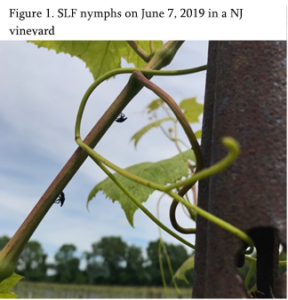
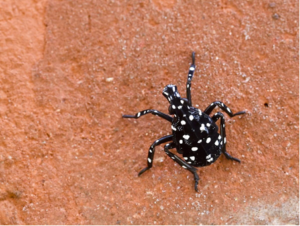
(Photo Credit: https://www.pottsmerc.com)
Why? Thus far, there has been no definitive research showing that young SLF nymphs cause damage to grapes. If SLF is feeding on grapes during the 1st and 2nd instar (nymph) stages, they are likely feeding on the fleshly new growth, not on the canes or cordon as the adults do.
However, these nymphs are also likely representing a very low number of the total population of SLF in and around the vineyard they are being seen at, because research has also shown that nymphs feed on multiple host plants. To further elucidate details of SLF life cycle, and feeding habits, we are surveying to determine which life stages are found in commercial vineyards throughout the growing season.
As you make a decision on whether to spray the nymphs in your vineyard, It is important to keep these two points in mind.
1) Do not overuse pyrethroids in a vineyard as they can flare mealybug populations which vector leaf roll virus.
2) Save highly effective insecticides with good residual (Brigade, Actara, Scorpion, Carbaryl, and Mustang Maxx) for use against the adults in late summer through harvest.
If you want a material to apply now while the nymphs are just becoming active in the vineyard, the biological pesticides, BoteGHA (1-2 qt/acre) or BotaniGard 22 WP (0.5- 2 lbs/acre), are effective against the nymphs and will minimally impact other pests. These products have Beauvaria bassiana, a beneficial fungus that attacks insects and has good efficacy against SLF nymphs and a 4 hour REI. Keep in mind when using B. bassiana materials, they take a few days to kill SLF and the fungal growth will turn the nymphs into fuzzy white cotton balls (Fig 2). As a biological material they work best under humid conditions. Recommendations tank mix compatibility for BoteGHA can be found here
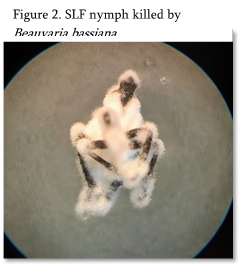
There are two other pests in NJ vineyards, grape berry moth and Japanese beetles, that commonly require management in the early summer. While there is no action threshold for SLF nymphs in the vineyard, management can be combined with existing pest management programs. Grape berry moth timing is approaching and we recommend using an insecticide that is effective against both SLF nymphs and grape berry moth if you have SLF nymphs in your vineyard (Table 1).
Just remember that the degree-day timing for grape berry moth is based on using growth regulators or diamide chemistries and application of a broad-spectrum material would be applied 1-2 days after the predicted timing. Japanese beetles typically occur in late June/July and again, there are insecticide materials that are effective against both SLF nymphs and Japanese beetle (Table 1).
Table 1. Insecticide efficacy against SLF nymphs and key grape pests
| Rating of Insecticide Efficacy* | |||
| Insecticide | SLF Nymph ** | Grape Berry Moth | Japanese Beetle |
| Avaunt 30SG | E | G | G |
| Brigade 10WSB | E | E | – |
| Entrust 2SC | F | G | – |
| Imidan 70WP | E | G | – |
| Carbaryl | E | G | G |
| Actara 25 WG | E | – | G |
*E – Excellent; G – Good; F – Fair; ‘-‘ not rated
**H Leach, DJ Biddinger, G Krawczyk, E Smyers, JM Urban 2019 “Evaluation of insecticides for control of the spotted lanternfly, Lycorma delicatula, (Hemiptera: Fulgoridae), a new pest of fruit in the Northeastern U.S.” Crop Protection 124:104833
The recommendations for spotted lanternfly control are centered around the adult stage which are considered the primary damaging stage. If adults are found in your vineyard they likely warrant management. In 2019 we saw SLF move into Northern NJ vineyards in large numbers at the end of September. It is important to note that they do not discriminate between vines that have been harvested or not. The only available threshold for SLF in grapes is 10 adults/vine, however this is quickly exceeded in some vineyards. We are recommending that growers apply a border spray targeting the vines on the borders or the first few panels if rows are perpendicular around your vineyard, with a focus on areas near hedgerows as it has been shown that those are the areas that SLF if most likely to congregate in at higher densities. Further information on adult SLF control, recommended insecticides and rates will be in a forthcoming Plant and Pest Advisory Post.
Integrating Management for Key Orchard Pests
By: Robert McDougall and Anne L. Nielsen
Integrated Pest Management (IPM) is the practice of using biological information to efficiently and effectively control pests while reducing reliance of pesticides. IPM is typically depicted as a pyramid of tactics that build on each other moving from least toxic at the bottom to most disruptive at the top. But in practice, IPM for insects in tree fruit relies primarily on application of synthetic insecticides guided by degree-day timing or trap counts. We want to flip the “IPM pyramid” around to emphasize that insecticides are the last tool for pest management and build upon other biologically-based practices.
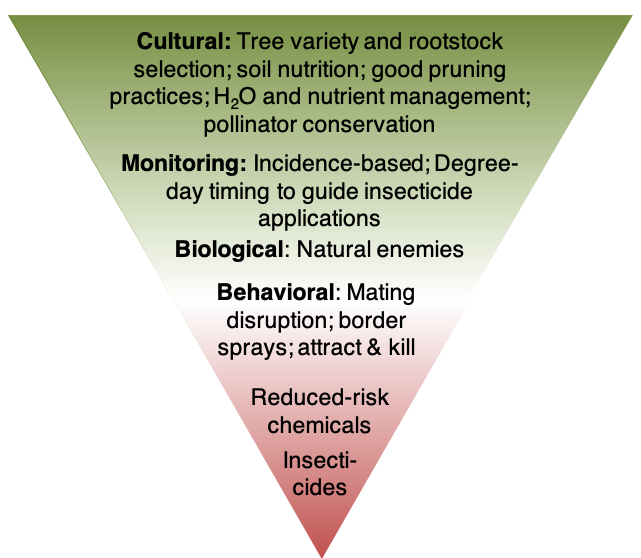
By Anne Nielsen
The least disruptive means of pest control are cultural measures, those that seek to prevent pests from becoming problematic in the first place. These can include measures such as planting resistant cultivars, practicing good hygiene to prevent pest entry and maintaining diverse plantings in crop margins to encourage natural biological control agents (e.g. other insects that eat pests). In tree fruit, cultural control may include rootstock resistant to wooly apple aphid or removal and burning of pruned limbs and dying trees (for borer or scale management) which removes infested plant material and habitat for other pests.
For curative action, a central component of IPM programs depends on monitoring programs to identify pest species, occurrence and seasonality, and abundance. This is achieved primarily through direct sampling of plant tissue or baited traps. Regardless of the monitoring method, it must be conducted frequently, weekly at best. Monitoring can also establish biofix dates to start accumulating degree-days that when applied to models predict life stages of insects based on available heat units for development.
Upon identification of key pests within the orchard, the next action can take on a wide range of forms depending on the pest. This can include biological control measures, such as enhancing or introducing a natural enemy of the pest into the system in the hope of controlling it. Interactions between natural enemies and pests occur naturally within an orchard, but the strength of the interaction can be weakened through chemical insecticides and lead to outbreaks of pests, particularly aphids, mites, thrips, and scales. Implementation of reduced input or non-chemical methods can protect populations of natural enemies such as predators or parasitoids within the orchard and prevent a pest from becoming actionable. An example of a biological control program currently under investigation is controlling the Brown Marmorated Stink Bug with the Samurai Wasp, a tiny stingless Asian wasp which lays its eggs in BMSB eggs, preventing them from hatching and producing more Samurai Wasps instead of stink bugs.
The next IPM tool is behavioral management which changes the behavior of the insect so that less insecticide can be used. Insects, like other animals, have predicable behaviors, that once understood can be exploited for management. Two common approaches include altering insect behavior with pheromones (ie. mating disruption or attract-and-kill) or exploiting dispersal behaviors to apply targeted management (ie. border sprays). Mating disruption uses a species’ own sex pheromone to reduce mating within the orchard. This is accomplished by placing multiple dispensers containing pheromone throughout the orchard. This changes the behavior of male moths that are searching for females and results in fewer females laying eggs within the orchard (and cleaner fruit at harvest). For many insect species, including Oriental Fruit Moth and borers, no additional insecticide is needed (based on monitoring trap thresholds). Mating disruption for Oriental Fruit Moth in peaches can cost the same if not less than insecticide management and is highly effective. Mating disruption technology against borers is becoming increasingly necessary as further use restrictions change for Lorsban.
The behavioral tactic attract-and-kill places high doses of pheromone, usually an aggregation pheromone, on select trees to attract males and females (and sometimes nymphs) to a tree where they can then be killed with an insecticide. It is not believed to bring additional insects into the orchard, rather it brings those that are already there into one area. A second type of behavioral control is the use of border sprays. Many insects are often found in greater numbers in the edges of orchards because their dispersal is arrested due to visual cues provided by trees on the orchard edge. A border spray is usually defined as spraying the outer rows of orchard trees with insecticide. This tactic has shown to be very successful for controlling brown marmorated stink bug in peaches and apples, and reduces insecticide sprays by 25% relative to alternate row middle applications. Plum curculio also exhibits this behavior, and Rutgers is currently investigating whether it can be effectively controlled by spraying just the outer two rows of orchards during movement into the orchard.
IPM practices have evolved considerably in the past few decades and orchards are managed safer and more efficiently each year. Some of the IPM tactics described above may already be part of your orchard management practices. But as production cost increases are not instep with fruit prices, tactics that rely less on insecticide inputs will help protect orchard viability.
2019 Wine Grape Twilight Meetings
The 2019 Wine Grape Twilight Meetings are being held in South Jersey on Wednesday, May 22 and North Jersey on Thursday, May 23.
See flyer for details.
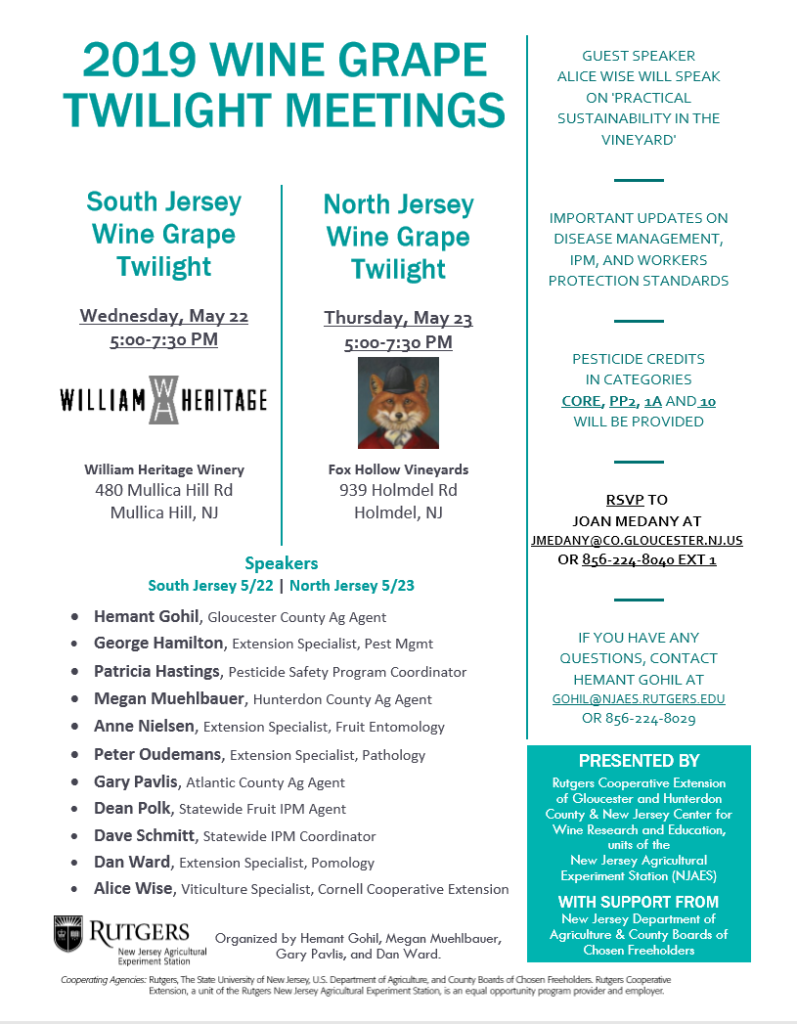
South Jersey Tree Fruit Twilight Meeting – I
When: March 27 @ 7 PM
Where: Gloucester County Extension Office, 1200 N. Delsea Drive, Bldg. # A, Clayton, NJ 08312
7:00 PM: Welcome Remarks and Updates.
Hemant Gohil, Gloucester County Agricultural Agent, Rutgers NJAES
Comprehensive Understanding of Spotted Lantern Fly in Orchard Crops
Heather Leach, Spotted Lantern Fly Extension Associate, Penn State University. Invited Speaker, Heather leach is specialist on Spotted Lanternfly (SLF). She will speak on the comprehensive understanding of SLF priorities from every perspective and provide latest information on biology, behavior and effective management techniques.
Pesticide Record Keeping Update.
George Hamilton, Extension Specialist in Pest Management, Rutgers NJAES
Food Safety Issues Related to Tree Fruit Production.
Wes Kline, Cumberland County Agriculture Agent, Rutgers NJAES
Management of Scale Insect in Peach
Anne Nielsen, Extension Specialist, Fruit Entomology, Rutgers NJAES
Early Season Disease Control
Norman Lalancette, Extension Specialist, Tree Fruit Pathology, Rutgers NJAES
Scouting Observations and IPM of Early Season Pests
Dave Schmitt and Dean Polk, State-wide Fruit IPM Agent, Rutgers NJAES
9:30 PM Pesticide re-certification credits application and Adjourn
Light fare will be provided. Please call Joan Medany jmedany@co.gloucester.nj.us or call 856-224-8030 if you are planning to attend.
This site is accessible to the physically impaired. If an additional assistance is needed, please contact Hemant Gohil (Program Organizer) at 856-224-8029 prior to the meeting.
Insect Management with Low Fruit Load
After the critically cold temperatures in early April followed by several other nights of below freezing temperatures, NJ peach and apple growers have experienced loss of blossoms and/or fruit set. While the extent of the injury may still be too early to tell for some varieties, the cold weather has not stopped insect pests and where no fruit will be harvested we need to adjust our approach to insect management. This provides an opportunity to use selective materials where possible and allow natural enemy populations to attack some key pests.
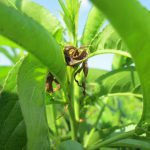
Terminal flagging from Oriental fruit moth egg laying
Oriental Fruit Moth lays its eggs of at least the first and second generation in peach terminals. Due to low or absent fruit loads, the trees will be very flush and provide lots of oviposition sites. Injury to terminals is noticeable by “flagging” of the terminals. If unmanaged, populations will be high in 2017 and could be difficult to control. Thus management of at least the first and second generation OFM needs to occur. I would strongly recommend using mating disruption, such as OFM TT, for unharvestable orchards. This will control all 4 generations and significantly reduce OFM pressure next year without harming beneficial insects. Mating disruption dispensers are placed in the middle of the tree canopy and can be placed now. See label for rate information. Sprayable mating disruption such as Checkmate OFM-F can be applied at 1.32 – 2.93 oz/A applied just prior to adult flight and again during flight. For chemical options, we generally use 5-6 male moths in a trap as a trigger for management. If monitoring traps exceed 5-6, then the use of either Madex HP or a diamide chemistry (ie. Altacor) is recommended. Madex HP is an insect virus that only attacks OFM and codling moth and is very effective in both research and commercial trials in NJ at rates from 1.5 – 3.0 oz/acre. Both Madex and the diamides will have minimal impact on natural enemies but have good control of OFM and should be applied at diamide timing according to the DD model (see NJ Tree Fruit Production Guide or PPA posts from IPM scouting). Codling moth and OFM in apple will likely not require management but should still be monitored. [Read more…]
